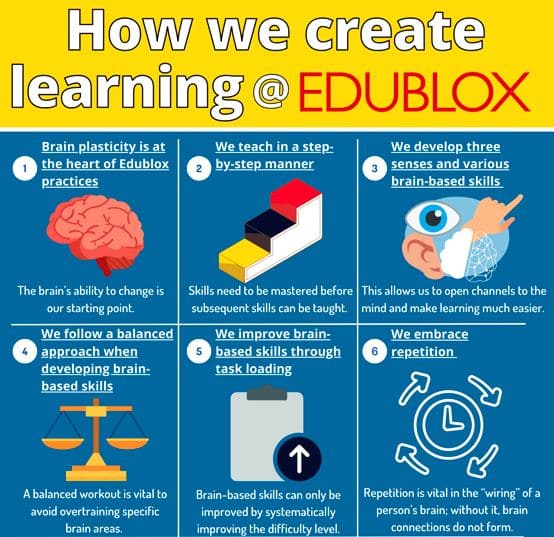
Edublox is an educational method that integrates cognitive training with reading, writing, or math tutoring and solid learning principles. Edublox assists students in becoming life-long learners and empowers them to realise their highest educational goals. While Edublox is not a quick fix, its use can permanently alleviate the symptoms of learning disabilities like dyslexia and dyscalculia. Here is how we create learning:
1. Brain plasticity is at the heart of Edublox practices
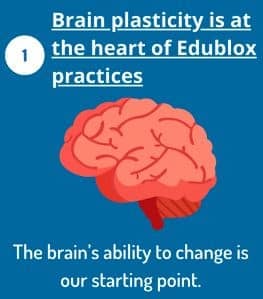
It was long believed that once we grow up, our brains have a set number of neurons performing functions in a fixed way.
Today, we know that the brain can change and adapt in structure and function throughout life and in response to learning. Named neuroplasticity or brain plasticity, the brain’s ability to change is Edublox’s starting point.
Because of neuroplasticity, treatments that include cognitive training — like Edublox does — promise a bright and productive future for individuals with learning disabilities like dyslexia and dyscalculia.
2. We teach in a step-by-step manner
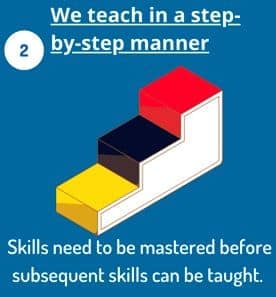
This age-old — but ageless — principle was already pointed out by Herbart (1776–1841). “One never, he insisted, apprehends anything in isolation, but always in terms of one’s background of previous experience and learning. So the first consideration in properly organized learning would be to ensure that the learner had the right background” (Mursell, 1954, pp. 210-211).
Putting it differently, students’ prior skills and knowledge can help or hinder learning. Specific preliminary skills need to be mastered first, before anyone can learn to play soccer or rugby. The same principle applies to reading, writing, and maths.
At Edublox, we distinguish between foundational brain-based skills that require cognitive training and foundational academic skills that require tutoring. Both need development to overcome learning disabilities like dyslexia and dyscalculia.
3. We develop three senses and various brain-based skills
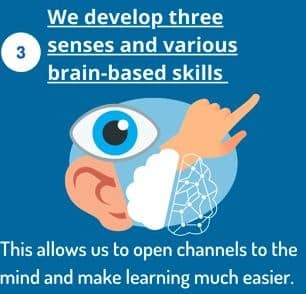
By learning to use three senses – seeing, hearing, and touch – we open three channels to the mind. Learning becomes much easier when we develop our foundational brain-based skills: concentration, processing, memory, and reasoning.
There is no doubt that a person’s weaker senses can be improved. A blind person, being deprived of sight, usually develops all the other senses extraordinary. To learn to read Braille, for instance, their tactile sense must be developed to a remarkable degree. This fact is important because it shows, without the help of complicated tests, that every sense can be developed and improved.
Edublox is well-known to improve cognitive skills, including focused attention, processing speed, visual memory, and auditory memory.
4. We follow a balanced approach when developing brain-based skills
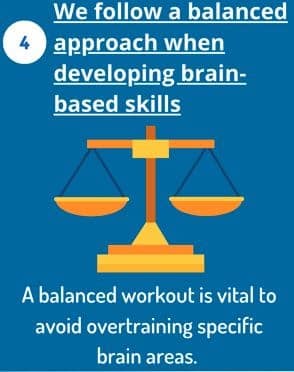
In physical training, a balanced workout is vital as overtraining one part of the body can cause deformity, for example, the Popeye syndrome when overtraining the biceps.
The brain is no different. For instance, in Maguire et al.’s experiment with London taxi drivers, growth in the posterior hippocampi seems to have come at a cost, as they had reduced anterior hippocampal grey matter volume compared with bus drivers, with anterior volume decreasing with more navigation experience (Maguire et al., 2006).
One should also consider the role of mutualism. A mutualistic view suggests that cognitive abilities mutually facilitate growth. For example, better reasoning skills allow individuals to improve their vocabulary more quickly, and better vocabulary is associated with faster improvement in reasoning ability (Kievit et al., 2017).
5. We improve brain-based skills through task loading
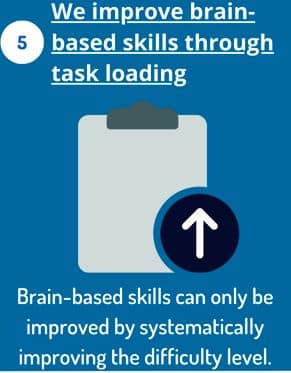
Research shows that strategies and techniques cannot improve brain-based skills. They can only be improved through task loading, i.e., by systematically improving the difficulty level.
In the classic experiment of Ericsson and Chase, transfer did not occur following 250 hours of short-term memory training. The student, known as SF, was required to repeat sequences of random digits. Every time he got a sequence right, a digit was added. When the experiment was concluded, SF could repeat sequences of a staggering eighty-plus random digits. However, when tested on random alphabet letters, his short-term memory performance immediately reverted to normal.
Through interviews, the researchers discovered that SF, a competitive runner, pictured an unconnected string of three or four digits as one single race time. In this way, he relieved the burden on short-term memory and, like any mnemonist, took advantage of an already existing code in long-term memory (Shenk, 2010).
One way to prevent students from using techniques or strategies is to offer a series of cognitive exercises.
6. We embrace repetition
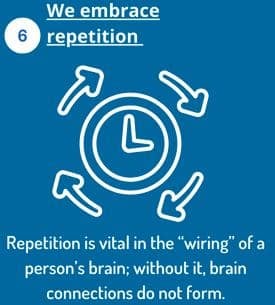
Repetition and drill-and-practice lead to fast, effortless, and automatic processing.
Knowledge ready in long-term memory is often required as a stepping-stone to understanding something deeper, making drill and practice essential to academic performance in the same way it is to the performance of a virtuoso violinist.
A meta-analysis by Swanson and Sachse-Lee of 85 academic intervention studies found that the largest effect sizes were obtained by interventions that included systematic drill, repetition, practice, and review.
From a neuroscientific perspective, repetition is vital in the “wiring” of a person’s brain, i.e., the forming of synapses or connections between brain cells. Without repetition, key synapses do not form.
7. We build a “pyramid of repetition” for beginner learners
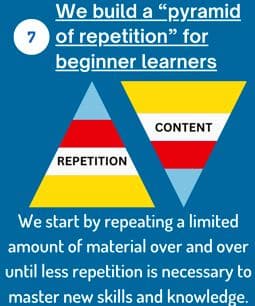
This principle is derived from the works of Shinichi Suzuki, a Japanese violinist, educator, and founder of the international Suzuki method of music education.
In his book Nurtured by Love, Suzuki explains that the beginner learner must start by repeating a limited amount of material over and over. But, gradually, less and less repetition will be necessary to master new skills and knowledge.
A “pyramid of repetition” can be constructed to develop both foundational brain-based and foundational academic skills.
8. We embrace flearning
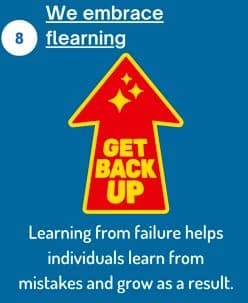
Everyone makes mistakes, and making them is vital to developing understanding.
Research at Stanford University has shown that synapses grow in the brain when mistakes are made, and there is growth even if errors have not been rectified. It is the struggle to get the correct answers that fosters growth. However, there is no growth when the answers are correct.
Teaching students that mistakes are positive has an incredibly liberating effect on them. Flearning – learning from failure – helps individuals learn from mistakes and failures and grow as a result.
9. We follow best practices in our programs
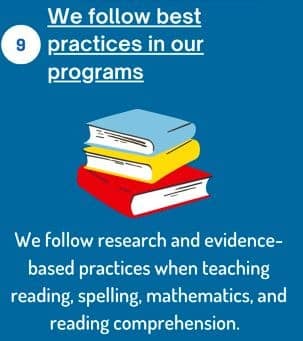
Our ancient ancestors figured out that one needs perfectly round wheels to comfortably get from point A to point B without walking.
The wheel does not always have to be reinvented, even in education. But sometimes, changes are needed in order to help children get from point A to point B in reading, spelling, maths, and reading comprehension.
However, when implementing changes at Edublox, we always follow research and evidence-based practices.





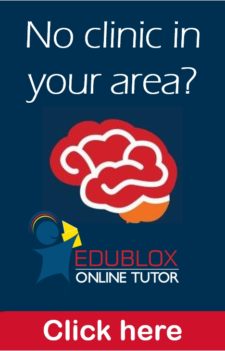
Leave a Reply